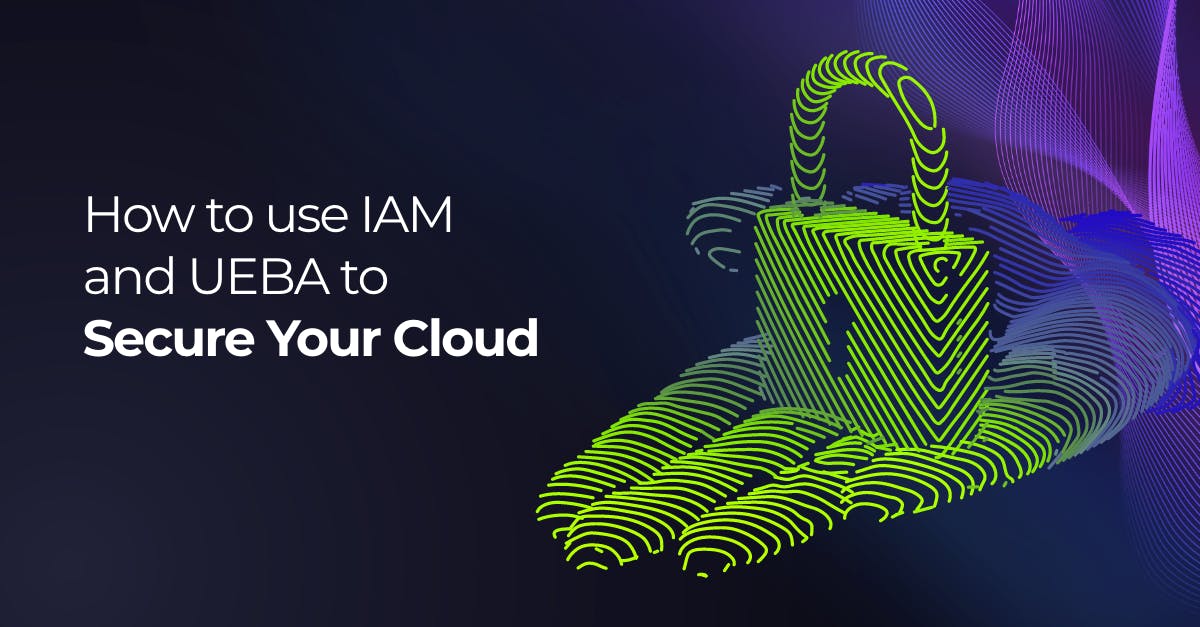Congratulations, you’ve successfully migrated some or most of your operations to the cloud and implemented a pretty comprehensive security posture to safeguard your data.
Great move, but let’s look at how you can further bolster that.
In this blog, we’ll examine how you can use Identity and Access Management (IAM) and User and Entity Behavior Analytics (UEBA) to further enhance your cloud security posture with an extra layer of protection against unauthorized access, data breaches, and other security threats.
Let’s first take a deeper look at what IAMIAM and UEBAUEBA are.
Identity and Access Management (IAM)
IAM refers to the policies and technologies that manage digital identities and access privileges of users within your organization. Essentially, they control access to cloud resources by authenticating and authorizing users, enforcing policies, and logging activity.
IAM enables you to control
- who can access your cloud resources,
- what actions they can perform on those resources, and
- when they can perform those actions.
In addition, IAM can help you meet compliance requirements by providing audit trails and access reports that demonstrate the who, what, when, and how of user activity.
For example, let's say you have an application running on Amazon Web Services (AWS). Using IAM, you can create a policy that allows a user to read data from an S3 bucket but not delete it. This ensures that only authorized users can access and perform actions on your data.
Some of the key features of IAM solutions include:
- Multi-factor authentication (MFA)
- Role-based access control (RBAC)
- Least privilege access
User and Entity Behavior Analytics (UEBA)
UEBA uses machine learning and Artificial IntelligenceArtificial Intelligence (AI) to analyze the behavior of users and entities in your cloud environment, therefore enabling you to detect and respond to security threats by analyzing and alerting you of anomalous behavior patterns.
In short, UEBA uses algorithms to help you identify patterns of behavior that deviate from normal activity and that may signal that something fishy is going on.
With UEBA, you can detect and respond to potential security threats in real-time.
Finally, UEBA also provides detailed insights into user behavior, which you can use to fine-tune access controls, improve overall security posture, and identify areas needing further improvement.
Now that we better understand what IAM and UEBA are, the next question would be: do they run on multi and hybrid cloud deployments?
Using IAM and UEBA in Multi-Cloud Environments
Today, many organizations like yours are adopting multi-cloud environments through hybrid deployments or using multiple cloud providers. Therefore, it is vital to have a security solution that can work across multiple cloud environments.
The good news is that IAM and UEBA can provide a consistent user experience across different cloud environments.
In other words, you will have a comprehensive view of security across your organization with centralized user management and access controls that can help you detect and respond to security threats across multiple cloud environments.
How about hybrid deployments, i.e., do IAM and UEBA work for organizations using both on-premises and cloud environments?
Using IAM and UEBA in Hybrid Deployments
It is even more important that IAM and UEBA can work seamlessly across both environments in hybrid deployments.
There’s good news again, so we can heave a sigh of relief.
For hybrid deployments, IAM is particularly beneficial for providing a consistent user experience across on-premises and cloud environments that include centralized user management, access controls, and multi-factor authentication, while UEBA can detect and respond to security threats in both environments, providing a comprehensive view of security across the organization.
Use Cases
I hope the above examples illustrating IAM and UEBA in hybrid and multi-cloud environments are helpful. To be more precise, let’s look at two usage examples of IAM and UEBA below.
Scenario 1: Protecting Sensitive Data
Suppose a healthcare organization stores patient data in a cloud-based electronic medical records (EMR) system.
The organization must ensure that only authorized personnel have access to the EMR system and that any unauthorized access is detected and addressed. To achieve that, they can use IAM to define roles and permissions for users who need access to the EMR system.
For example, the organization can create roles for doctors, nurses, and administrative staff, each with appropriate access to the EMR system.
They can initially implement policies that require strong passwords and multi-factor authentication to restrict access from unauthorized devices or locations, then utilize UEBA to monitor user behavior within the EMR system, looking for unusual activity that may indicate a security breach.
You can also read our case studyread our case study on how Nalagenetics uses our flagship CSPM, Warden, to do this.
Scenario 2: Ensuring Compliance
Consider a financial organization implementing a cloud-based customer relationship management (CRM) system.
The organization must ensure that it meets ISO 27001 and SOC 2 compliance standards, which require strong access controls and user behavior monitoring for unusual activity.
To achieve that, the organization can use IAM to define roles and permissions for users needing CRM system access.
For example, the organization can create roles for customer service representatives, sales representatives, and managers, each with the appropriate level of access to the CRM system. The organization can also implement policies that require strong passwords and multi-factor authentication to restrict access from unauthorized devices or locations.
UEBA can monitor user behavior within the CRM system, looking for unusual activity that may indicate a security breach, e.g., when a user is attempting to access data they don't usually access or when a user is accessing data outside of regular business hours.
By using IAM and UEBA in tandem, the financial organization can meet ISO 27001 and SOC 2 compliance standards.
Click herehere to read a related case study on how Vaultbox, a customer of ours, uses our CSPM, Warden, to attain compliance.
Moving toward the Principle of Least Privilege
The Principle of Least PrivilegePrinciple of Least Privilege is not new but has become prominent recently, especially towards the end of 2022.
Essentially, the Principle of Least Privilege, or PoLP for short, is a security principle that dictates that users should only have access to the resources they need to perform their job function and nothing more. This means that even if a user account is compromised, the attacker will only have limited access to resources.
To move towards the Principle of Least Privilege, you should conduct regular access reviews to ensure that your users have only the access they need to do their job.
In other words, access should be granted based on the " need-to-know " principle and a least privilege basis based on job functions and business requirements.
Here’s a quick overview of how IAM and UEBA can be utilized to help achieve PoLP:
- Conduct an Access Review: Conducting an access review is the first step to implementing PoLP. This involves reviewing the roles and permissions of each user in your organization to ensure they have only the access they need to perform their job functions. This process helps identify any users who have unnecessary access to sensitive resources.
- Next, you need to define roles and permissions properly: Once the access review is complete, you can use IAM to define roles and permissions for each user. Users should only be given the access they need to perform their job function and nothing more. You can achieve this by creating roles that reflect the different job functions in the organization and granting the appropriate permissions to each role.
- Enforce Policies: In addition to defining roles and permissions, you should also enforce policies that require strong passwords, multi-factor authentication, and restrict access from unauthorized devices or locations. By doing this, you can ensure that only authorized personnel can access the necessary resources.
- Monitor User Behavior: Now, use UEBA to monitor user behavior and look for any unusual activity that may indicate a security breach. UEBA can detect when a user is attempting to access resources they don't usually access or when a user is accessing resources outside of regular business hours.
- Set the monitoring system to trigger an alert to the appropriate security personnel when such behavior is detected so they can immediately investigate to determine whether the access was legitimate or not.
- Finally, conduct Regular Access Reviews: You should conduct regular access reviews to ensure that users have only the access they need to do their job. This helps ensure that your organization adheres to the PoLP and helps you reduce the risk of unauthorized access.
Conclusion
IAM and UEBA are essential tools for securing your cloud environment.
By combining these two tools, you create a comprehensive security solution that helps protect your sensitive data from unauthorized access and data breaches, ensure the security of your cloud environment and protect your business from potential security threats.
Additionally, moving towards the Principle of Least Privilege can further increase security by limiting access to only what is necessary, therefore ensuring the security of your cloud environment and protecting your sensitive data from potential security threats.
For maximum protection, you can consider implementing a Cloud Security Posture Management (CSPM) solution like WardenWarden, which integrates IAM and UEBA with other security features to provide comprehensive security for cloud environments. Contact us for more information or to arrange a demo today!




